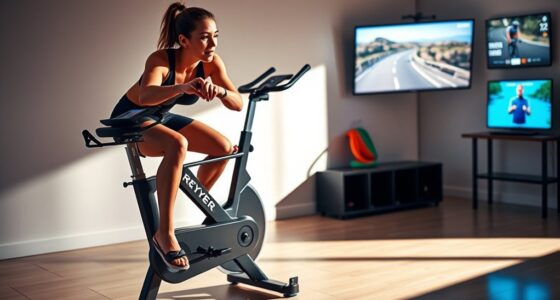Cycling’s surrounded by myths that can mislead you. For example, it doesn’t always guarantee weight loss and pricey bikes don’t assure better performance. You might think cycling only works your legs, but it actually engages your entire body. Plus, cycling’s for everyone, no matter your age or size. It’s safer than you think, and you don’t have to ride long distances to get fit. Stick around to discover more truths about cycling that’ll enhance your experience!
Key Takeaways
- Cycling can lead to weight loss, but success relies on diet, metabolism, and overall activity levels, not just cycling alone.
- The performance of a bike depends more on the rider’s skill and comfort than its price; budget bikes can perform well.
- Cycling engages multiple muscle groups, providing a full-body workout that strengthens the core, glutes, and arms, not just the legs.
- Cycling is inclusive and accessible to all body types and fitness levels, promoting physical activity regardless of age or shape.
- Short rides of 20 minutes or more can significantly improve cardiovascular health and mood, making cycling effective without long distances.
Myth 1: Cycling Always Leads to Weight Loss
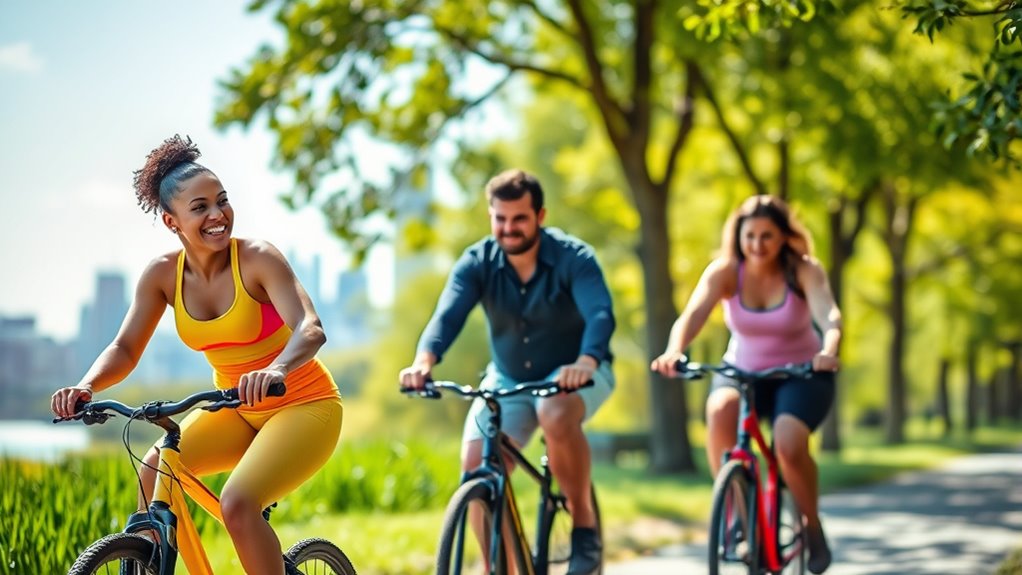
While many believe that cycling automatically leads to weight loss, the reality is more complex. Your success depends on various factors, including your diet, metabolism, and overall activity levels. Just hopping on your bike won’t guarantee results.
Studies show that combining cycling with a balanced diet greatly enhances weight loss outcomes. Also, cycling intensity matters; shorter, high-intensity rides can burn more calories than longer, leisurely ones. If you don’t increase the intensity or duration, your body may adapt, leading to reduced calorie burn over time.
Plus, remember that cycling can increase your appetite. If you don’t manage your food intake alongside your rides, you might counteract your weight loss efforts without even realizing it. Incorporating meals like Turkey Bean and Tomato Zoodle Bowl can help maintain a balanced diet while cycling.
Myth 2: More Expensive Bikes Guarantee Better Performance
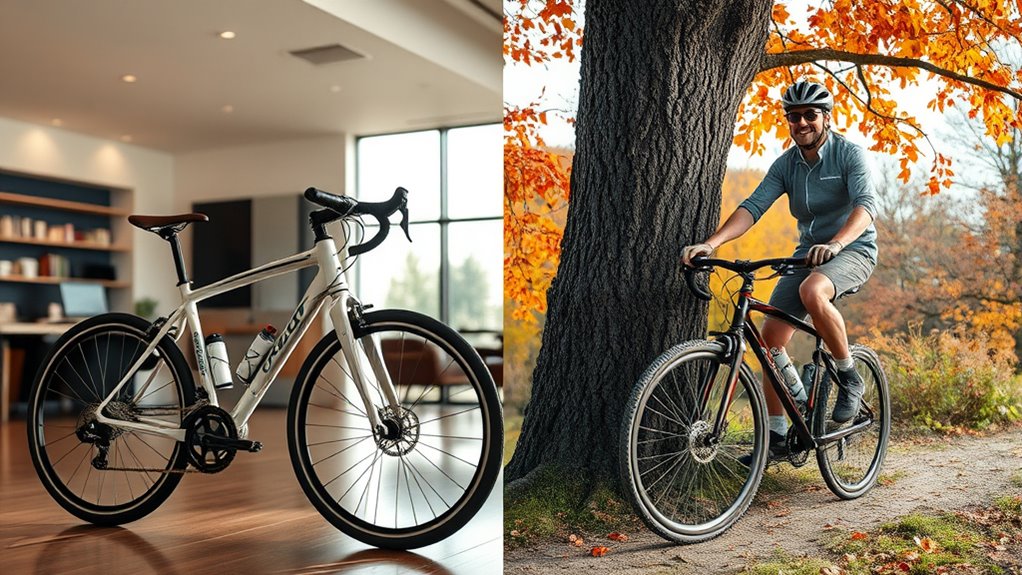
You might think that spending more on a bike automatically boosts your performance, but that’s not always the case.
Many cyclists achieve great success on budget-friendly models, proving that skill and comfort matter more than price.
With modern technology, even affordable bikes can deliver quality and enjoyment, making them a smart choice for riders at any level. In fact, gear recommendations can often provide valuable insights into budget-friendly options that excel in performance.
Performance vs. Price Discrepancy
Many cyclists believe that spending more money on a bike guarantees better performance, but this isn’t necessarily true. The performance vs. price discrepancy is often exaggerated by common myths. While higher-priced bikes may feature lightweight materials and advanced technology, many affordable models can still excel in major events without sacrificing performance.
Numerous successful cyclists began on budget-friendly or second-hand bikes, proving that skill and fitness are more important than price. Even lower-priced components from trusted brands like Shimano and SRAM deliver reliable performance. Additionally, early socialization in cycling skills can enhance a rider’s adaptability and confidence on the road.
Skill Over Gear Importance
Performance in cycling hinges more on the rider’s skill and fitness than on how much was spent on the bike. Many successful cyclists began their journeys on budget bikes, proving that skill trumps price.
Modern tech means even lower-cost bikes can perform well, so focus on your abilities instead of the bike’s price tag.
Consider these factors:
- Your training and experience directly impact your performance.
- Comfort and fit matter more than a high price.
- Many competitive riders conquer courses on affordable bikes.
- Determination often outweighs the gear you ride.
In the end, it’s your skill that propels you forward, not the cost of your bike. Additionally, cultivating a growth mindset can help you embrace challenges and improve your riding skills over time.
Value in Affordable Options
While it’s easy to believe that a pricier bike automatically leads to better performance, the truth is that affordable options can deliver impressive results. Many successful cyclists started their journeys on budget-friendly or second-hand bikes, proving that quality can exist at lower price points.
Modern technology has enhanced the reliability and performance of lower-priced components, making them a smart choice for many riders. Brands like Shimano, SRAM, and Campagnolo offer high-quality parts that won’t break the bank, ensuring that comfort and safety come first. Additionally, adopting a 50/30/20 rule for budgeting can help cyclists allocate funds effectively for their cycling needs.
Local bike shops also provide budget-friendly options, making cycling accessible without the hefty price tag. So, don’t underestimate the value in affordable options; a great ride doesn’t always mean spending a fortune.
Myth 3: Cycling Only Benefits Leg Muscles
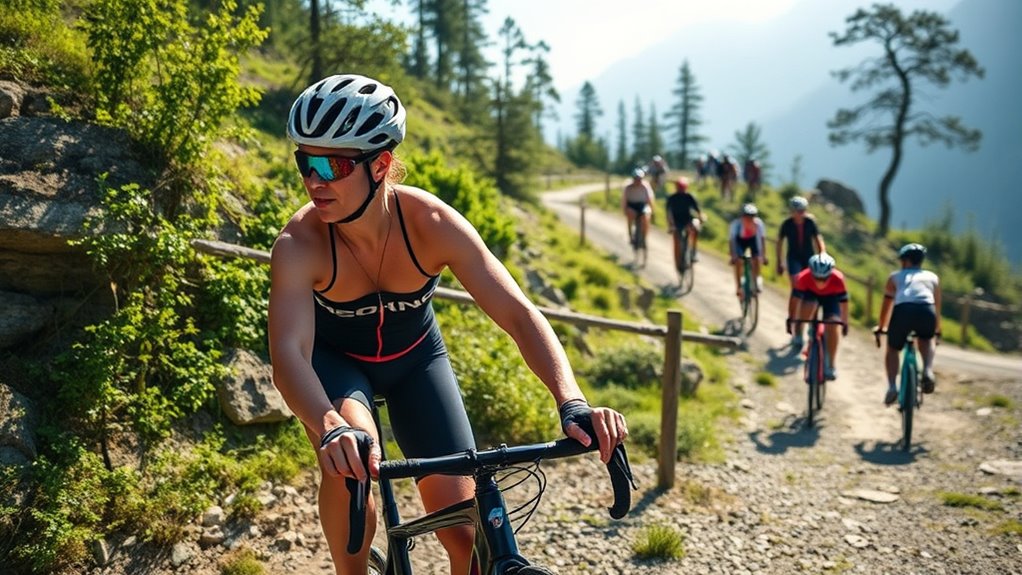
Cycling often gets pigeonholed as a workout solely for your legs, but that couldn’t be further from the truth.
In reality, cycling provides a full-body workout that engages various muscle groups, including your core, glutes, and arms.
Here are some key benefits you mightn’t know:
- Strengthens your core and upper body
- Boosts cardiovascular fitness for heart and lung capacity
- Increases muscle endurance and tone across multiple groups
- Enhances flexibility and coordination
Whether you’re pedaling uphill or changing your posture, every ride contributes to your overall physical performance. Additionally, anti-odor running apparel can enhance comfort during longer rides by keeping you fresh and dry.
Myth 4: You Have to Be a Certain Type of Cyclist
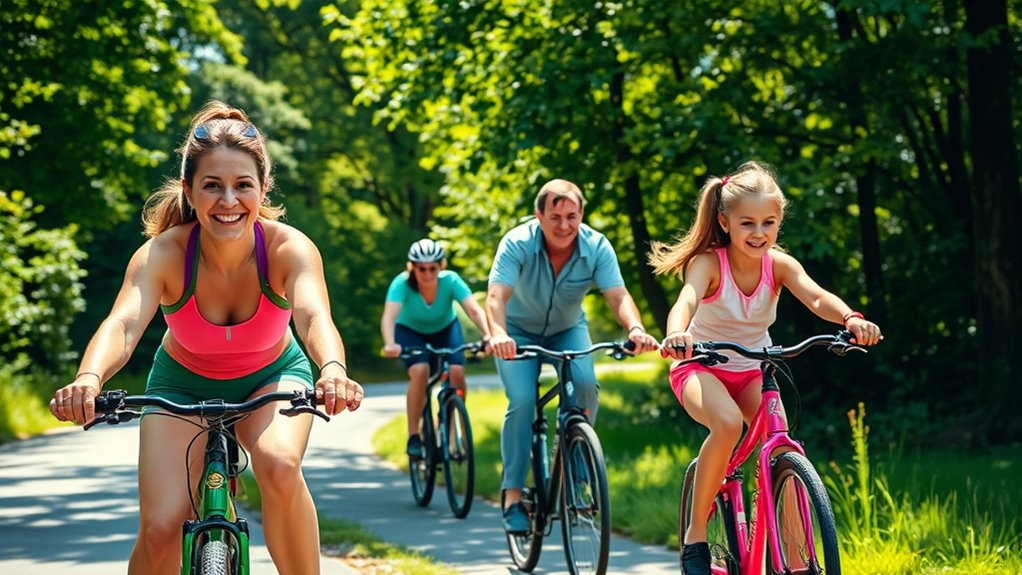
Why do so many people believe you have to fit a specific mold to enjoy cycling? The truth is, cycling is an inclusive activity that welcomes everyone, regardless of body type or fitness level.
Successful cyclists come in all shapes and sizes, proving that ability isn’t limited to the stereotypical lean, muscular build often portrayed in media. Prominent athletes like Marianne Vos and Marley Blonsky advocate for cycling’s accessibility, showing that joy in riding transcends body type and discipline.
The cycling community is increasingly embracing inclusivity, encouraging participation from diverse groups. Engaging in cycling promotes physical activity and well-being, making it a beneficial pursuit for anyone, no matter their experience or appearance. Additionally, participating in community support can enhance the cycling experience by connecting riders with others who share similar interests and goals.
Myth 5: Cycling Is Only for Young People
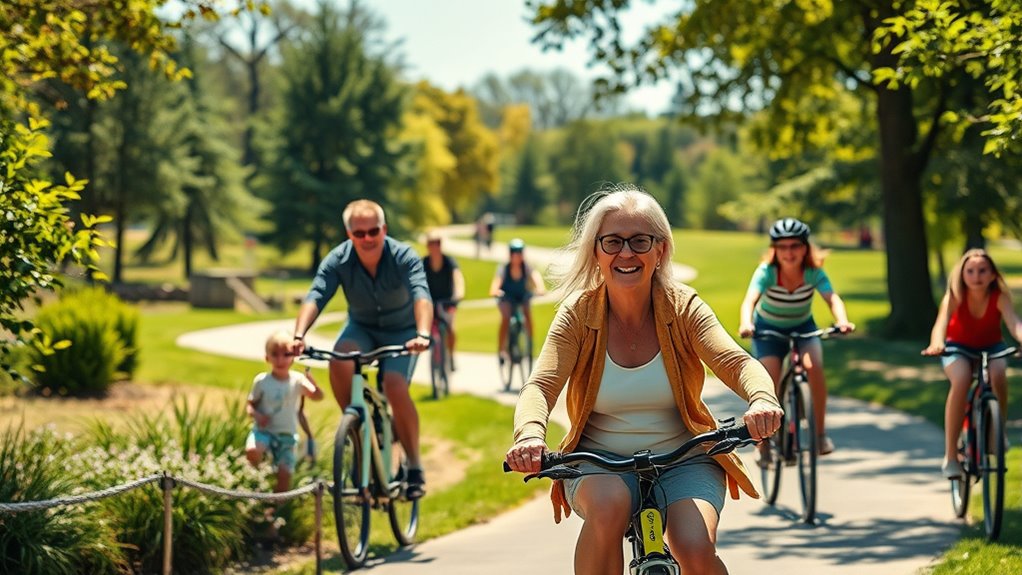
Many people mistakenly think cycling is just for the young, but the truth is that riders of all ages can enjoy this wonderful activity.
In fact, cycling offers numerous benefits for older adults, making it a fantastic choice for staying active. Consider these points:
- Improves cardiovascular health, keeping your heart strong.
- Increases mobility, helping you maintain independence.
- Fosters community, connecting you with fellow riders of all ages.
- Adaptable for all abilities, ensuring everyone can participate.
Many older adults actively engage in cycling events and community rides, proving that age doesn’t limit your ability to enjoy the sport. Additionally, cycling can be a part of a broader long-term strategy for maintaining physical fitness and overall well-being.
Myth 6: Cycling Is Too Dangerous

You might think cycling is too dangerous, but studies show it’s actually a safe way to get around, especially with safety measures like helmets and bike lanes.
In fact, the fatality rate for cyclists is much lower than that for drivers. With more communities investing in cycling infrastructure, you can ride with greater confidence and safety. Additionally, engaging in cycling can contribute to lower carbon emissions, making it an eco-friendly transportation option.
Safety Measures Exist
While some might believe cycling is too dangerous, the reality is that it can be one of the safer modes of transportation when proper safety measures are in place.
By implementing specific strategies, you can enhance your cycling safety greatly:
- Designated bike lanes reduce the likelihood of accidents.
- Education on road rules empowers you to ride confidently.
- Safety gear, like helmets and lights, protects you during rides.
- Access to recreational trails offers safer environments away from traffic.
Communities that invest in cycling infrastructure see fewer injuries, proving that effective planning can make a difference. Additionally, the use of portable camping toilets can encourage more people to cycle to remote areas, knowing they have proper sanitation options available.
Statistics Support Cycling Safety
Even with concerns about safety, statistics reveal a different story about cycling. According to the National Highway Traffic Safety Administration, only 0.2% of all traffic fatalities involved cyclists in 2020, showing cycling is relatively safe compared to motor vehicle travel.
In fact, cycling can reduce your risk of cardiovascular disease by 50% compared to non-cyclists, highlighting its health benefits despite perceived dangers. While most cycling injuries occur in urban areas, investing in bike lanes can greatly enhance cycling safety. Communities with dedicated bike lanes see a 40% decrease in cyclist injuries.
Plus, research shows that cycling is safer than walking, with cyclists facing fewer injuries per mile traveled. So, embrace cycling—it’s safer than you think!
Myth 7: You Need to Ride Long Distances to Get Fit
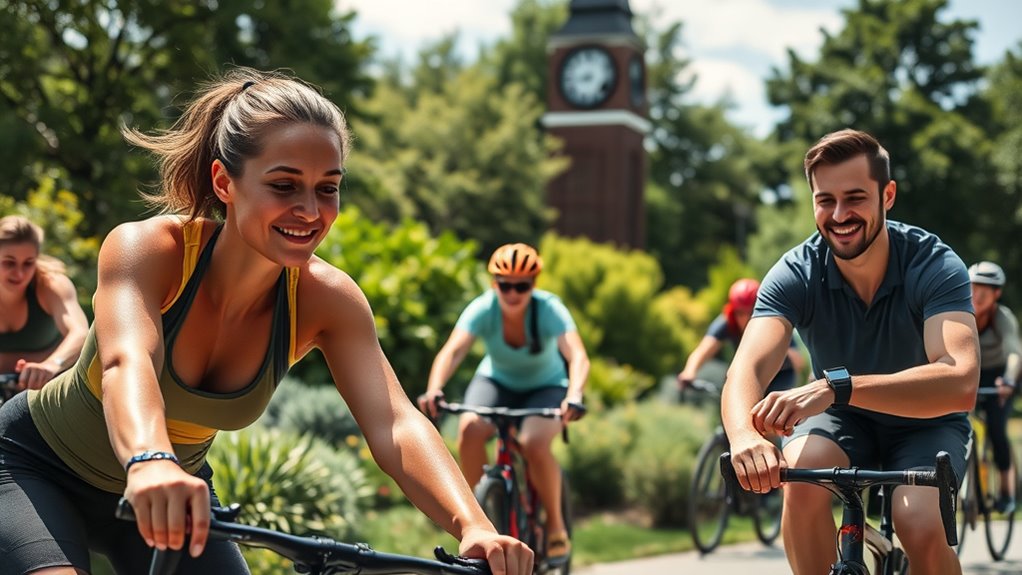
Many people believe that only long-distance cycling leads to fitness, but that’s simply not true. Shorter rides of 20 minutes or more can effectively improve your cardiovascular health and overall well-being. You don’t need to commit to longer rides to reap the benefits.
Consider this:
- Even brief cycling sessions reduce stress and boost your mood.
- Moderate intensity in shorter rides can be as effective as longer, intense efforts.
- Consistency is key; regular short rides lead to gradual fitness improvements.
- Engaging in varied activities like interval training enhances fitness without long distances.
Myth 8: Cycling Is Too Complicated and Technical
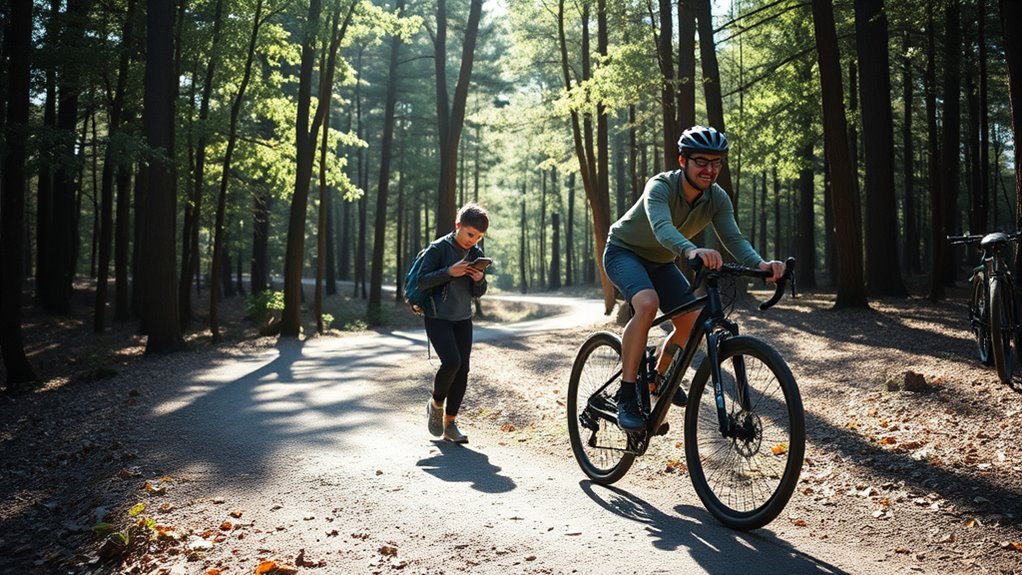
Cycling often seems intimidating due to the misconception that it’s overly complicated and technical. In reality, you don’t need extensive technical knowledge to enjoy cycling. Basic maintenance skills, like checking tire pressure and lubricating the chain, are usually enough.
Many modern bicycles are designed to be user-friendly, allowing beginners to ride without needing advanced technical skills. Plus, local bike shops, online tutorials, and community cycling groups provide valuable support to help you learn.
Cycling can be as simple or complex as you want it to be. Whether you prefer leisurely rides or want to tackle performance-driven challenges, you can easily get started without expensive gear or intricate setups.
Frequently Asked Questions
Can Cycling Help Improve Mental Health and Reduce Stress?
Absolutely, cycling can boost your mental health and cut down on stress.
When you pedal away, you release endorphins that enhance your mood and create a sense of well-being. The rhythmic motion and fresh air can clear your mind, allowing you to think more clearly.
Plus, it’s a great way to disconnect from daily pressures.
How Often Should I Cycle for Optimal Benefits?
Imagine cruising down a sunlit path, the wind whipping through your hair.
For ideal benefits, you should aim to cycle at least three to five times a week. Each session can last from 30 minutes to an hour, depending on your fitness level and goals.
Consistency is key; it’ll not only boost your physical health but also enhance your mood and mental clarity.
What Type of Bike Is Best for Beginners?
When choosing a bike as a beginner, you’ll want something comfortable and easy to handle.
A hybrid bike is often a great choice, blending features of road and mountain bikes. It’s versatile for various terrains, making your rides enjoyable.
Don’t forget to check for proper sizing; a well-fitted bike will enhance your experience.
Also, consider factors like weight and gear options that suit your riding style.
Happy cycling!
Is Indoor Cycling as Effective as Outdoor Cycling?
You might wonder if indoor cycling‘s as effective as outdoor riding. The truth is, it can be just as beneficial!
Indoor cycling allows you to control intensity and focus on specific training goals without external factors like weather. You can push yourself harder in a structured environment.
Plus, many indoor cycling classes incorporate intervals and varied resistance, making your workouts fun and effective.
Ultimately, your commitment and effort will determine the results, whether inside or outside.
What Safety Gear Is Essential for Cycling?
When you cycle, wearing essential safety gear is vital for your protection. A well-fitting helmet‘s a must to protect your head in case of falls.
Reflective clothing increases your visibility, especially in low-light conditions. You should also consider gloves for grip and hand protection, along with padded shorts for comfort on longer rides.
Don’t forget to use lights and a bell to alert others of your presence. Stay safe and enjoy your ride!
Conclusion
To sum up, don’t let these myths hold you back from enjoying cycling. Whether you’re riding for fun, fitness, or transportation, the joy of cycling can be yours at any age or skill level. Remember, you don’t need to pedal across the country to reap the benefits—just a short ride can feel like flying. So grab your bike, hit the road, and embrace the freedom that comes with every turn of the pedals!









